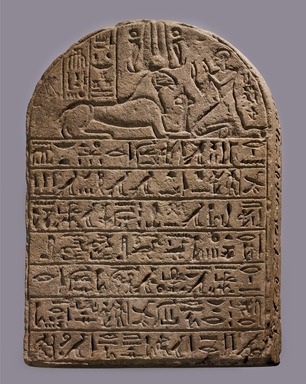
Artist:NubianEgyptian
Medium: Sandstone
Geograhical Locations:
Dates:ca. 1292–1190 B.C.E
Dimensions: 19 3/16 x 14 x 3 in., 47.5 lb. (48.8 x 35.6 x 7.6 cm, 21.55kg)
Collections:
Exhibitions:
Accession Number: 38.544
Image: 38.544_Gavin_Ashworth_photograph.jpg,
Catalogue Description: The stela is of conventional form with round top. There are 7 registers of horizontal hieroglyphs on the face while the lunette is occupied by a relief of a recumbent ram-headed sphinx before whom a kneeling man worships. The sphinx wears an elaborate crown with two feathers flanked by a pair of uraei wearing sun disks. Over the sphinx are two vertical registers of hieroglyphs behind the man. There is also a long vertical register of hieroglyphs on each side of the stela. The back is very roughly hewn. The workmanship is average, the sandstone is the typical coarse Nubian sandstone which has weathered to some extent on the face of the stela. The inscription is said to record an agreement between a mother and her son and daughter, the son being a priest in the temple. The children agreed to provide for the mother in old age in return for which she turned over to them her property. Condition: The lower right corner is broken but is practically intact. The lower part of the rear of the stela has broken loose but has been replaced and is practically intact.